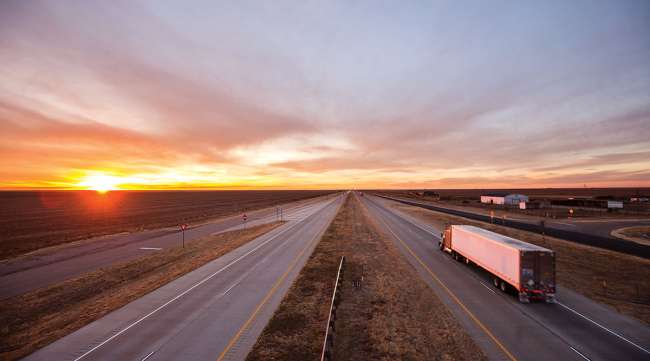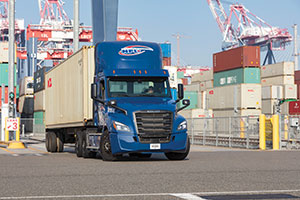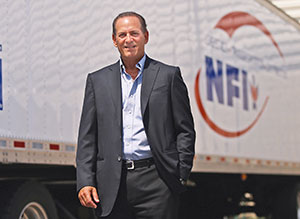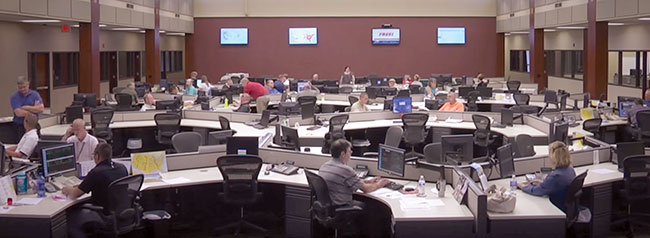Special to Transport Topics
How the Coronavirus Pandemic Might Reshape Trucking’s Future

[Stay on top of transportation news: Get TTNews in your inbox.]
The world changed nearly overnight due to the novel coronavirus pandemic and governments’ responses to it, but analysts postulate it will take a long time to return to a semblance of normalcy.
Some changes that have occurred within the trucking industry might pass quickly as communities reopen and business revives, but others are expected to remain in place for a long time, or even permanently.
The pandemic’s effects on commercial transportation and logistics are clear, running the gamut from health and safety to operational and economic.
Industry participants and analysts say the fluid situation makes it difficult to predict what the transportation environment will be like in six months — much less years from now — but certain long-term trends already are starting to emerge.
Keeping Drivers Healthy
Health and safety practices were among the first things to change in commercial transportation and logistics. Managers educated essential employees about best practices for hand washing and disinfecting equipment. Social distancing protocols soon followed, along with implementing remote work for most back-office employees.
Heightened safety measures for commercial truck drivers during the pandemic go beyond the standard societal concerns. Drivers have a higher average age than many other professions, and many harbor pre-existing conditions such as obesity or heart disease. Those factors put them at higher risk of severe illness if they contract COVID-19. Carriers are acutely aware of this and take extra precautions to protect this core segment of their workforce.
Many fleets started providing on-site employees and drivers with protective personal equipment such as face masks and gloves. That practice is predicted to remain in place indefinitely.
“There will continue to be lots of emphasis on personal safety around providing protection to those employees,” said Sid Brown, CEO at truckload carrier NFI. “That will continue for a period of time until they come up with a vaccine or medication and people feel comfortable again that they won’t catch the infection.”

NFI truck operating at a port. (NFI)
Some pickup and delivery locations have started checking drivers’ temperatures before they are allowed on site, and many others ask drivers to stay in the cab while in-house employees empty or fill trailers. Those customs also are expected to be in place for a while.
“The flow of paperwork and the interchange between a driver and the workforce either at the pickup point or delivery point may be limited. ... It might permanently change that way,” Brown said.
As far as operations “going back to normal all of a sudden and we’re through with this, I don’t think that’s going to happen,” he added.
NFI, based in Camden, N.J., ranks No. 18 on the Transport Topics Top 100 list of the largest for-hire carriers in North America.
An idea that some health experts and government officials have been considering as a way to prevent further COVID-19 spread is a medical card or bracelet to indicate that a person has had the illness or has been vaccinated, once a vaccine comes to market. That is another item that drivers would have to make sure they carry at all times, said ARL Network President Ron Faherty.
Economic Hardship, Future Opportunity
Although the coronavirus health and safety measures emerged suddenly, the stage was set for economic shakiness in the transportation industry even before the public health crisis shut down much of the economy.

Faherty
“We already had the conditions for slow growth in 2020 and 2021, compared with 2019. COVID accelerated that, but it already was set for a slowdown,” said Jean-Dominique Bonnet, mobility principal consultant at Frost & Sullivan.
The observation is not lost on transportation companies.
“We began to see a general slowdown in the economy in the fall of last year … and then the pandemic pounds on top of that,” ARL’s Faherty said.
Signs pointed to a looming nationwide recession, and commercial transportation is directly related to the overall economy, Bonnet said.
Plus, truck manufacturers were showing softness, and their activity often is a bellwether for the transportation industry as a whole.
“The market for medium- and heavy-duty trucks already was supposed to drop [approximately] 30% pre-COVID, and now it is dropping 40%,” Bonnet said. “My take is it will end 50% lower compared to last year. That is a lot, but not a disaster.”

Bonnet
Although many comparisons are circulating between the financial crisis of 2008-09 and the current economic turmoil, key differences exist that could stunt or slow recovery efforts this time. First, the loss of disposable income was steeper and more severe during the pandemic — with 14.7% unemployment in April — than it was during the previous financial crisis, when unemployment peaked at 10%.
The resulting drop in consumer spending will likely keep freight demand low for nonessential goods. The current financial hit and sustained reduced volumes inevitably will cause a series of bankruptcies and consolidation in the commercial transportation industry, sources said.
“This has been the perfect storm. A lot of motor carriers have not experienced or seen a down market,” ARL’s Faherty said. “It’s a very, very thin margin business with a huge amount of liabilities, and it eats cash. You have to be strong stomached to be in this business for any length of time.”
On the positive side, the International Monetary Fund predicts that global economies will rebound strongly in 2021.
Likewise, transportation analysts anticipate growth within the industry next year, especially in terms of freight volumes.
A supply and demand imbalance likely will result in tighter carrier capacity in 2021, said Bart De Muynck, research vice president at Gartner. Consequently, freight rates are expected to increase.
While transportation companies work to stay afloat during this crisis, analysts recommended that they simultaneously start planning for growth in 2021 and 2022.
“If you are sitting back and doing nothing right now… you’re going to start missing the opportunities next year,” De Muynck said.
Adjusting Operations
Within the span of about two weeks in March, remote work became the norm for millions of workers, including many non-driving transportation industry employees. This is one trend that is nearly universally believed to have staying power.
A certain portion of many carriers’ back-office workforces will remain remote when stay-at-home orders lift.

NFI CEO Sid Brown (NFI)
“Does that mean we’ll never go back to an office? No. But I do think it means we may end up having 20%, 30%, 40% of the workforce working remotely on a rotating basis,” NFI’s Brown said.
The transition to more remote work would result in less need for office space, which translates to cost savings for trucking companies that choose to downsize their offices.
Meanwhile, calls for near-shoring manufacturing and material sourcing have grown throughout the pandemic as supply chains come under scrutiny due to temporary product shortages. Revamping supply chains will affect what goods trucking companies transport and how they do it.
Concurrently, consumers are relying far more on e-commerce while physical stores are closed. Analysts expect a certain level of permanence to that trend as more consumers realize the benefits of e-commerce. That, too, will impact how goods are transported throughout the supply chain.
“Everyone’s understanding is that even after we go through this pandemic, people will continue some of that changed buying behavior … not at that high level, but the expectation is levels for last-mile deliveries will remain higher than pre-crisis,” Gartner’s De Muynck said.

Once full, this dispatch office shows how workers are spaced out while working. (YouTube)
Last-mile parcel delivery volume has increased precipitously during the pandemic, De Muynck said. That has bumped up sales of final-mile transportation assets such as delivery vans. In the future, this shift could affect the mix of vehicle types at some transportation businesses.
“We’re seeing a lot of investment in last-mile delivery assets rather than buying tractors and trailers — this year so far we’ve really gone to a new low in terms of investment and buying new trucks,” De Muynck said.
Despite the larger parcel volumes, last-mile deliveries constitute a lower-margin business sector. The desire to improve margins and profitability could prompt innovation that drives long-term changes in last-mile operations.
At the same time, longhaul truckers’ detention time has ticked up during the pandemic, in part because of the time it takes to carry out extra safety and sanitizing practices at destinations. But it also was affected by workforce reductions, both for social distancing purposes and layoffs from financial fallout.
The pandemic has turned driver turnover rates on their head. In an industry where turnover rates are notoriously high, they plummeted almost immediately when the pandemic struck because people with jobs largely stayed put as many others across the economy faced layoffs.
Low turnover is expected to last at least through the end of the year as the economy rebuilds. It is too early to quantify the industrywide trend, but individual transportation business leaders say the difference in retention is significant.
►Essential Work, Truckers Rise to the Challenge
►Top 100 For-Hire Interactive Map
►Pandemic Exacts Heavy Financial Toll on Trucking Companies
►Sanitation, Social Distancing Become New Normal in Trucking
Sector Rankings
LTL | TL/Dedicated
Intermodal/Drayage
Motor Vehicle/Driveaway
Tank/Bulk | Air/Expedited
Refrigerated | Flatbed/HS
Package/Courier | Mail
Household Goods/Commercial
“Driver turnover is at a record low. We have seen a reduction in our turnover by at least 50%, if not more,” Brown said.
But it might not last, and carriers might have increasing trouble attracting new talent.
“Long term, I don’t see a workforce wanting to haul freight across the country,” Brown said. “This pandemic has created a sense of wanting to stay closer to home and family.”
Lower turnover rates lead to fewer training costs and lower truck driver accident rates. Another factor contributing to fewer accidents is the precipitous drop in traffic as more people stay at home.
Less traffic also contributed to shorter trip times and more ability to turn trucks around for additional deliveries. Plus, there is less wear and tear on trucks and their components when drivers operate at a steady pace.
Traffic will return as more people head back to their offices, but some commuter traffic would be eliminated permanently with the anticipated shift to a more remote workforce.
“I think we’ll end up with a quarter of our workforce working remotely and not commuting every day,” Brown said. “Magnify that against every company, and you just took 20-25% of traffic off the highways. That’s a big number.”
Regulatory Outlook
The pandemic has already had a short-term effect on transportation regulations.
In March, the Federal Motor Carrier Safety Administration temporarily waived driver hours-of-service limits for commercial carriers transporting emergency relief supplies or essential goods.
The COVID-19 outbreak also highlighted policy disparities at the state and federal levels. Various states implemented different pandemic responses, and the state approaches varied from the federal government’s approach.
“Interstate trucking unfortunately has to be exposed to both state and federal regulations,” Brown said. “A lot of times the two aren’t in sync and it becomes confusing for trucking companies to operate under conflicting regulations.”
Longer-term ramifications for trucking’s regulatory environment may also be on the horizon.
Bonnet, of Frost & Sullivan, suggested that the financial strain of the pandemic could slow down environmental regulations, such as further emissions reductions or advancing natural gas and electric vehicles.
Without a regulatory impetus to investigate greener vehicles, carriers are more likely to hold off on purchasing them because of their higher upfront cost.
It is difficult to determine when vehicle electrification discussions might regain momentum, but analysts estimate a one- to three-year delay based on economic recovery projections.
“Every time the industry is going into a recession, people are not investing in new trucks — whether combustion engine or electric,” De Muynck said. “Because of the industry being in trouble, we’re going to see less investment in things like electric vehicles.”
On the flip side, supply chain challenges and surging demand for last-mile deliveries could prompt permanent regulatory action to support other emerging technologies.
“We see that maybe regulators will open up to new technologies like drones and autonomous vehicles. We’ve seen them being more adaptive to that. It might drive more technology adoption,” De Muynck said.
Keep on Truckin’
Despite stay-at-home orders and the perception that much of the world has ground to a halt, trucking companies must continue moving forward.
Transportation businesses that did not have contingency plans for emergencies have been struck particularly hard during this crisis. For companies that fall into that category, now is the time to put such emergency and resilience plans in place. Devising and revising action plans now could prove crucial if the coronavirus resurges in the fall and winter as many health experts predict.
Sources speculate that driver pay will rise going into 2021 as companies face mounting pressure to retain drivers when transportation volumes rebound. Plus, professional drivers are receiving more public appreciation as the importance of well-functioning supply chains gains attention.
“Being a firefighter, I was looked at differently after 9/11. I would hope truck drivers continue to be looked at differently after this pandemic,” ARL’s Faherty said.
The constant state of flux during the pandemic makes it difficult to predict the lasting changes that will occur, but one thing is clear:
“I would imagine our world will look extremely different on the other side of this,” Faherty said.
Want more news? Listen to today's daily briefing:
Subscribe: Apple Podcasts | Spotify | Amazon Alexa | Google Assistant | More


